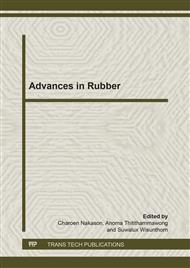p.377
p.381
p.385
p.391
p.395
p.399
p.406
p.410
p.417
Maturation of Cup Lump Natural Rubber: Growth of Microorganisms and Effects on Quality Properties under Alternative Storage Conditions
Abstract:
Natural rubber is the main raw material in various rubber products. STR 20 is the most produced type of raw natural rubber in primary rubber production, due to its high global demand for tire production. In the STR 20 standard process, mainly raw cup lump is used, and the microbial populations in the cup lump affect the properties of the raw material during intermediate storage that cannot be avoided. The goal of this study was to evaluate the extent of such maturation effects, and to examine alternative practical storage condition extremes to determine which one is the best, based on quality characteristics. We screened microorganisms in matured cup lump, and evaluated the key properties determining raw material quality, under various maturation conditions. Maturing cup lump under closed air conditions gave a high population (1.69x1010 CFU/ml) of microorganisms at 3 to 7 days, and the population decreased with further maturation to 3.45x105CFU/ml at 28 days. Raw rubber quality properties (pH, Initial Plasticity and Plasticity Retention Index) were best when stored under shade in spraying water, and worse with storage under closed bag conditions. The best thermal stability and the smallest microorganism population were found in acid coagulated cup lump. The results suggest that cup lump should be acid coagulated, and stored in the shade in spraying water, for best results in STR20 production.
Info:
Periodical:
Pages:
395-398
Citation:
Online since:
November 2013
Authors:
Price:
Сopyright:
© 2014 Trans Tech Publications Ltd. All Rights Reserved
Share:
Citation:


